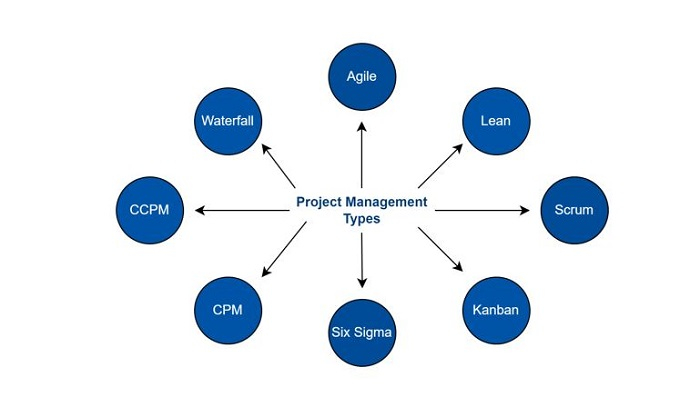
 Data Structure
Data Structure Networking
Networking RDBMS
RDBMS Operating System
Operating System Java
Java MS Excel
MS Excel iOS
iOS HTML
HTML CSS
CSS Android
Android Python
Python C Programming
C Programming C++
C++ C#
C# MongoDB
MongoDB MySQL
MySQL Javascript
Javascript PHP
PHPPhysics
Chemistry
Biology
Mathematics
English
Economics
Psychology
Social Studies
Fashion Studies
Legal Studies
- Selected Reading
- UPSC IAS Exams Notes
- Developer's Best Practices
- Questions and Answers
- Effective Resume Writing
- HR Interview Questions
- Computer Glossary
- Who is Who
Types of Project Management Explained
Every project that businesses work on has a clear goal and a deadline and is intended to add value by producing a superior result, good, or service. Additionally, a committed team, a set of goals, a budget, and a timeframe are established for obtaining the desired objectives. Effective project management can help organize, plan, and oversee a project to accomplish a certain objective or result. In this article, we will go through the different types of project management techniques.

What is Project Management?
Project management is the discipline that involves using certain procedures and guidelines to originate, plan, carry out, and oversee how new initiatives or changes are handled inside an organization. It includes techniques and knowledge applications for completing projects in line with the project acceptance standards and within specified constraints. It contains deliverables that are limited by a specified spending limit and timeline.
The outcome and limited time frame distinguish "project management" from simple "management," which is an ongoing activity. Projects have life cycles because they are meant to only last for a while. A project management life cycle begins when the project is started and ends when it is finished or terminated in some other way.
Types of Project Management
1. Waterfall
The waterfall model is a classic and linear approach to project management that has been used for many years. This is similar to traditional project management but with the added constraint that each task must be completed before moving on to the next. Progress is linear and flows in one direction, much like a waterfall. This makes paying close attention to work sequences and deadlines crucial in project management. For instance, the team members finish one project stage before starting the next. This approach largely emphasizes the significance of documentation.
Agile
The agile technique divides a project into stages and small segments called sprints. Before starting another section, a project team finishes the previous one. Every project typically includes three to five sprints, and when each sprint is over, the project team reviews the completed work and makes any modifications that are required by the need. Agile is based on taking little, gradual moves.
One of the advantages of the Agile approach is eliminating the need for team planning and allowing the project team to work on projects in portions. Other features include adaptability, planning, and simple project method development.
Lean
Lean is a project management methodology that prioritizes client satisfaction and efficiency. A project manager may do more with fewer thanks to lean. This approach strongly emphasizes teamwork, waste reduction, and the Mura, Muda, and Muri concepts. While Mura focuses on removing variables to balance the workload, Muda emphasizes reducing procedures and processes that provide no value. Muri assists in reducing excessive workload, which can prevent staff burnout. The lean approach seeks to reduce waste and boost effectiveness. Key Lean principles include highlighting value from the customer's perspective and mapping out the complete project in the early stages to discover where you can produce value and minimize waste.
Scrum
Scrum is a project management system that implements agile concepts. Self-organizing teams may create large projects using the scrum technique. Scrum operates based on five principles: openness, respect, bravery, commitment, and focus. Scrum uses small teams, quick development cycles, regular communication, and assigned tasks to execute Agile concepts to keep the project structured and on schedule.
Scrum aims to boost cooperation, communication, and development speed. This approach allows a project manager to discuss every aspect of the project in real-time by segmenting it into digestible sprints. Scrum is ideal for smaller teams who want to iterate quickly.
Kanban
Kanban is an agile approach that emphasizes the necessity of continuous workflow and is primarily concerned with the organization. Based on the process, Kanban divides the project into smaller parts and phases. This project management approach emphasizes productivity and workflow visualization while giving your project flexibility.
In Kanban, the project's tasks are displayed as cards on a board with columns, either physically or digitally. The task cards move to the subsequent column as progress is made on them until they are finished. The Kanban technique encourages continuous workflow. In conjunction with other techniques like Scrum or Lean, Kanban is frequently employed.
Six Sigma
Six Sigma is a quality management approach that focuses on reducing development faults. The initial step in this procedure is locating and eliminating the error's root cause. This method guarantees consistency in output and project quality. In the Six Sigma process, project managers use quality control methods that rely on statistical and empirical data to reduce mistakes.
Six Sigma attempts to increase quality by detecting errors in the project. The fact that Six Sigma works by analyzing and interpreting data gives an organization a chance to organize and examine its data to accomplish a project. This is a data-driven approach to project management and thus can assist a company or project manager in determining the customer’s needs.
Critical Path Method (CPM)
CPM project management generates a list of activities that involve complex operations and establishes connections between these tasks. It aids in identifying the trickiest element that can adversely impact project completion.
CPM creates models that include all the tasks specified in a WBS, their durations, and any task dependencies. This information may determine the task sequence required to complete the project. This is referred to as the critical path. Teams that use CPM determine how long each task will take to complete and how much work will be needed to finish a project. This assists in creating a project's overall plan and gives the client a precise project timetable.
Critical Chain Project Management (CCPM)
The CPM approach is an alternative to CCPM because CPM emphasizes time, whereas CCPM places more emphasis on resources, including people, physical space, and equipment. It is a less technical approach to project management focusing more on resource balancing and flexibility than task sequence or timetable. This project management strategy is used after developing the basic project schedule and task dependencies. As a result, project managers may select their team and resources while staying within a certain budget.
One benefit of adopting CCPM is that it helps in resource conservation and ensures that the project stays within a pre-established budget. Even with all of these benefits, CCPM may be used by teams who only work on one project simultaneously.
Conclusion
There are about as many management approaches as there are projects. But they all have one thing in common: they complete their projects on schedule and within budget. The various approaches outlined above are beneficial in some or all projects, depending on the nature of the project. They aid in proper workflow and quality management without compromising the budget and the deadline.

